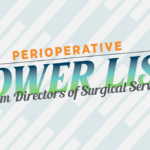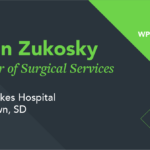Lean Six Sigma
Tools for Improving the Quality of Surgical Services
Healthcare organizations have been increasingly using Lean and Six Sigma since these closely related management techniques were introduced into the healthcare field about 15 years ago. In 2012, the American Society for Quality reported that 40 to 50 percent of healthcare organizations had used Lean or Six Sigma processes. At Whitman Partners, we’ve observed an increase in the numbers of Directors of Surgical Services who have received training or led or participated in Lean or Six Sigma processes, as well as healthcare organizations that require or prefer training in these principles and techniques for their Directors.
What are Lean and Six Sigma?
Lean and Six Sigma arose decades ago in the manufacturing sector to improve quality and efficiency. Lean Thinking was developed by Japanese companies, particularly Toyota, as an alternative to traditional ways of thinking about production and waste, and to continually improve processes. Six Sigma came out of efforts by Motorola and other U.S. companies to further quality improvement; it refers to the goal of having a minimal number of defects and reducing variability.
In practice, many Directors of Surgical Services and others in healthcare who use these processes combine the available tools and practices from both methodologies, falling under the now-common name of “Lean Six Sigma.” They appreciate the flexibility of using whichever tools and approaches can solve the sticky problems facing their team and workplace—and in the end increase efficiency, lower costs, and, most of all, increase patient satisfaction.
Lean Six Sigma and Healthcare
The Institute for Healthcare Improvement noted in 2005 that, “Agreement is growing among health care leaders that lean principles can reduce the waste that is pervasive in the U.S. system.” Another seminal paper in a Dutch journal published the same year, said that “Lean and Six Sigma have strongly complementary strengths that are particularly useful for systematically developing healthcare service innovations.”
Early adopters in healthcare found strong evidence of the applicability and value of Lean Six Sigma for their organizations, most notably Virginia Mason Medical Center in Seattle. Reports and articles in the healthcare press since then have predominantly underscored the successes of organizations using these methods, increasingly adding strategies for more effective use of Lean and Six Sigma. An article on the Fierce Healthcare website in 2011 noted that Lean and Six Sigma in healthcare can mean “preventing medical errors, decreasing mortality rates, reducing lengths of stay, improving patient care, and improving quality. . . Lean Six Sigma allows hospitals to balance the seemingly mutually exclusive goals of providing cost-effective, high-quality care.”
Lean Six Sigma in Surgical Services: Firsthand Accounts
We interviewed three Directors of Surgical Services affiliated with Whitman Partners who have led Lean Six Sigma projects at their organizations: Michelle Sebern, Nora Bass, and Mary Gwartney. We hope that their accounts, edited here for space and clarity, will give our readers a relevant look at how these management practices might also work for them in their positions as Directors of Surgical Services.
Michelle Sebern, MSN, Regulatory and Clinical Practice Specialist, Bonner General Health, Sandpoint, Idaho
One important Lean Six Sigma project I worked on in Surgical Services came up because we were having a hard time retaining recovery room nurses. The pool of recovery room nurses was so small, and they were getting hit with calls. Every time they were on call they were actually working on call, two or three nights a week, and burning out. Fiscally we didn’t have any more FTEs that we could give to the recovery room. But there across the hall was another group of nurses, endoscopy nurses, who were taking calls for the GI docs, but never coming in on call. Those endo nurses had similar skill sets: they recovered patients, not necessarily surgical patients, but at least they knew about anesthesia and sedation medications. So we ended up working to combine those nurse forces.
Initially the driver was to have better nurse retention in the recovery area. But in the end what happened was, using Lean, we created these efficiencies and cross-trained the nurses. Now we had far better coverage for the recovery room, because now endoscopy nurses knew PACU. And PACU nurses started learning endoscopy. All of a sudden we had this fluidity in what used to be silos.
Lean looks at the things that we need to implement to gain these efficiencies. I don’t necessarily use true Six Sigma, which is really complicated. Six Sigma tends to use what’s called the DMAIC model, which is you define it, you measure it, you analyze it, you improve it, and you control it. It gets to be so big. I tend to use the simpler model: Plan, Do, Study, Act, PDSA. It’s really like tiny little bites. What do we need? Okay, endoscopy nurses need recovery room training. Okay, let’s do that. What does that look like? Let’s plan it, let’s try it. Did that work? Are the nurses trained? Oh, they’re not trained yet. Let’s go back to the table. Let’s plan it, let’s do it. And you keep cycling PDSA until you’ve got it. Then you measure it. How is our coverage, and ultimately retention? So that was a big, successful project using Lean and a modified Six Sigma using PDSA.
I always think of Lean as the strategic part. You’re trying to gain an efficiency, save money, and trim the fat, get lean. A lot of times that aligns with the goals of an organization, because that’s what they want. But Lean doesn’t necessarily tell you how to trim the fat. For that you need another model, like PDSA or Six Sigma.
Resistance happens with every single change project. It’s going to be difficult to get everyone to buy in. It was fortunate that I had really good physician buy-in because what the anesthesia providers were seeing in the PACU was the turnover and burnout of recovery room nurses. We also got buy-in because those endoscopy nurses started to gain and appreciate this great new skill set. Some of them went on to be recovery room nurses in bigger hospitals.
A lot of times the issue is that somebody’s workload is going to increase or change. You always start the first meeting trying to discover common purpose. You present the problem, and adopt an engaging style that talks about the rewards of what we’re going to do. It’s easy to get adopters early if it’s going to directly help patient care.
One thing Lean does well is creating efficiencies across multiple departments in an organization. We had learned that we were having an increase in central line infection. We know from the literature that central line infection rates decrease by having fewer people to do it. At this hospital the primary care nurses were all changing central line dressings. A nurse who has, say, five other patients and is changing a central line dressing may or may not do it as well as somebody who is allocated as a resource for it. We recognized that taking the primary care nurses out of that dressing change was going to help with our infection rate.
But then what Lean did was ask if there was anybody else in the organization who needs more productivity that could change central line dressing. We learned that respiratory therapy, which was a non-revenue-generating, ancillary department, needed more productivity. We got buy-in from the respiratory therapists, and trained them, because it’s in their scope to change central line dressings. So during every shift a respiratory therapist was designated to change central line dressings. Although at first it was scary for them, the nurses loved it, because now they’re not having to get sterile and change central lines, and they can continue to take care of their other patients.
Respiratory therapists got a new skill set. Their revenue department gained income, because now they’re able to charge for central line dressing. Our infection rate went down, because we had more consistency in the people that were doing it.
If you can be successful with rapid cycle change and not wallow in it for too long, people see that success and they’re more inclined to then do it again. And it creates momentum.
If I had to give advice, it would be to go to any change management training you want. Then, do something. It doesn’t matter what it is. As soon as you start seeing tiny little successes, you’ll have these aha moments where you’ll see how you can get teams to move quicker or more efficiently, or identify the next step. Even now when I lead teams through Lean and PDSA, I modify my strategy and learn something new every single time.
Nora Bass, MSN, MBA, Manager of CVC Operating Room, Frankel Cardiovascular Hospital, University of Michigan,
Ann Arbor
Most of the work I have done has been related to program development. I have used Lean principles consistently as a leader. I am certified in Six Sigma & Lean, and while I work a process reliant on achieving a metric, I am less reliant on the rigorous statistics of a true Six Sigma project. There’s a lot of overlap.
Lean and Six Sigma are incredibly useful tools. When I was at Providence Hospital in Southfield, Michigan, leadership felt that it was critical that leaders understood how to remove waste and how to look at their work to standardize care and reduce waste. I was trained in Lean Six Sigma and identified as a leader who would be responsible for a value stream analysis. We embarked with a black belt on a year’s worth of projects to eliminate waste and standardize care for the orthopedic service line. We assessed data, did A3s, completed several events, and monitored the data and outcomes.
From there I did any number of Lean Six Sigma projects around perioperative services. As an example, we found that patients often got called five and six times before they had surgery by various departments within the organization. Alternatively, they were lucky to get one call after discharge. So we looked at how we could streamline getting information from patients before hospitalization. Patients were much happier with fewer redundant phone calls.
When working for Parkview Health System in Fort Wayne, Indiana, I was responsible for surgical and procedural areas. We often experienced scheduling conflicts between anesthesia and the endoscopy center. Anesthesiology was not being well coordinated by the GI department. We did a couple of projects to streamline work between the practices, with scheduling, and then with anesthesia as well as the department to better coordinate the daily work. It was a very big win for everyone.
Staff empowerment is the best part of these projects. You bring in frontline staff, who understand the nuances better than anyone else, and you elicit their understanding and ideas about difficulties and what would make the situation better. These are folks who will not only have great ideas, but they will also own the work that is critical to the success of the project. When you bring diverse groups together, everyone starts to understand the separate realities, so it’s a very positive relationship builder.
When we talk about patient flow and process, it becomes quite easy to see gaps in care, overlap, and wasted steps. It is amazing what we have patients navigate to receive care. We use value stream mapping as a process to walk through graphically to understand the patient’s flow. It’s the easiest way to get people thinking about how to change behavior or practice. In value stream mapping you take post-it notes and map out all the steps in the process along a wall. When you see it, it can be overwhelming, but then we then look at what we might take out of the process to simplify or combine things just to have the patient navigate less.
One of the best tools I’ve ever used for plotting out a project is a two-page A3 document. It defines the project owner and executive sponsor, the project, and its history in brief. Then the A3 asks you to identify how you measure this problem and then define tactics to move the process. Identifying the data ahead of time paves the way for understanding what will demonstrate success. Mapping out a project in this fashion makes you think through the problems you’re trying to solve. It’s nice to say things are better. But what does better look like?
One of the other tools I like is the 5S, which means Sort, Straighten, Shine, Standardize, Sustain. It’s about cleaning up, organizing, and putting standards into place. You’re reducing how much time a person spends looking for a product. If I know where to find a size seven glove, then I’m not going to spend ten minutes looking for it. It will be in the same place every time. This is a great tool as it relates to operating room equipment and product inventory in procedural areas.
I believe that Lean and Six Sigma training are must-have tools for Directors of Surgical Services. It’s an analytical way of thinking about the work we do, and is especially necessary for procedural areas. There are many programs out there for training. It has been great training for me, and I’ve used it so much it is how I think/view/handle just about any problem I face relative to operations. I just love it.
Mary Gwartney, MSN, Interim Director, First String Healthcare, Irvine, California
My first experience in Lean and Six Sigma practices was about 20 years ago. The innovative organization that I worked for did not call it Lean or Six Sigma, but they incorporated the principles, and in doing so forecast the future of healthcare in business. This hospital decided that we needed to decrease the cost of the supplies we were ordering, which would end up decreasing the cost to the customer. The cost savings in supplies ended up being about a million dollars.
Everywhere I go I always incorporate the Lean Six Sigma principles. With Lean you want to increase value to the customer, decrease the resources, and take out the waste. With Six Sigma you want to show improvement in your business practices or processes. You have to do it from the top down. Your entire organization has to make this part of their quality initiative to improve customer service, decrease waste, and decrease the cost to the customer. In surgical services, it can be as simple as coming together as a group with the same vision that we can get the best value for the buck. The simple thing we did was sourcing knife blades for surgery. We went with one vendor and saved three million dollars for the year.
Another project was at a facility that wanted to decrease OR minutes per patient. If you decrease the minutes of surgery you’re not only decreasing risk and the cost of surgery, but you’re enhancing the quality of service provided. We compared data such as surgeries per physician, history of the patients, age, demographics, time of surgery, complications, and equipment and products used for the surgery. We analyzed equivalent surgeries and compared.
We looked at best practices: maybe this one surgeon is significantly decreasing his OR minutes and his cost of surgery is twenty percent less than other surgeons. We look for reasons for that: did they have a piece of equipment that decreases OR time? So that’s how you do Lean Six Sigma. When I was interim at a large organization, we decreased our surgical cost by $265,000 for the year using these processes.
You need to bring these methodologies into your everyday practices. You have to live and breathe these principles every day and keep it live. You have to have it be a part of your culture, interwoven throughout the entire organization, for it to be successful. And we always bring it back to the patient: by looking through the eyes of the customer, you can easily increase your patient satisfaction scores.
You empower all your team members and do a shared governance to bring your team together as one. We work together analyzing, defining, deciding what we want to work on, and coming up with that plan. And along the way there are a lot of bumps in the road. You meet with those individuals and use your tools to really explain how important they are to the team, and why this is important to all of us. When you do that, you’ve got to know who your leaders are—your informal leaders, drivers, and formal leaders—and have them on board. You bring in your politics. From there, you’ll succeed, because they’re going to help you motivate and inspire the team.
No matter what level of the organizational structure they’re in, your team is all one team. You develop the trust and develop that relationship with all your members. It’s challenging, and some people will resist change. I look at change theory. You give them a short period to grieve the old days and let them vent. And then you say, now we’ve got to let it go and move forward.
Directors of Surgical Services need Lean and Six Sigma training, one hundred percent, especially with today’s challenges. Lean and Six Sigma are great and growing. We’ve been talking for many years about change in healthcare, and it’s challenging for many organizations right now. You really have to prepare and forecast and be ready.
SOURCES CITED
Institute for Healthcare Improvement white paper (2005). “Going Lean in Health Care.”
De Koning, H., Does, R.J.M.M., & de Mast, J. (2005). “Lean and Six Sigma.” Kwaliteit in bedrijf.
Overland, Dina (2011). “The buzz around Lean Six Sigma in hospitals.” FierceHealthcare.com.
Special thanks
Michelle Sebern, MSN, RN
Michelle is a Regulatory and Clinical Practice Specialist at Bonner General Health in Sandpoint, Idaho, where she leads interprofessional teams using Lean Six Sigma, PDSA, and Just Culture to facilitate process improvement. She is known for her ability to bring about desired organizational change through her unique mix of shared accountability, ability to build strong relationships with different types of people, and a high degree of emotional intelligence that promotes
cooperation and diplomacy.
NORA BASS, msn, mbA
Nora is a seasoned perioperative leader with experience in operations, strategy, physician recruitment, business development, process improvement, and clinical excellence. She is certified as a Six Sigma Black Belt/Lean Management, with substantial experience as a process owner, facilitator, and executive sponsor. She currently has oversight of Michigan Medicine’s Cardiovascular Surgery Department, the University of Michigan Frankel Cardiovascular Center/Ann Arbor. Her tenure includes senior leadership experience with Trinity, Parkview Health System, & Ascension.
Mary Ann Gwartney, BSN, MSN
For more than 25 years Mary has been demonstrating consistent success in perioperative leadership, with a strong management and clinical background. She is a certified Lean Six Sigma Black Belt. Currently Mary is a consultant and Interim Administrator at the First String Healthcare, AMN Healthcare Company, in Irvine, California. She previously held numerous interim positions directing Surgical Services, Nursing, and Emergency Departments at hospitals that include Cassia Regional Medical Center in Burley, Idaho.











